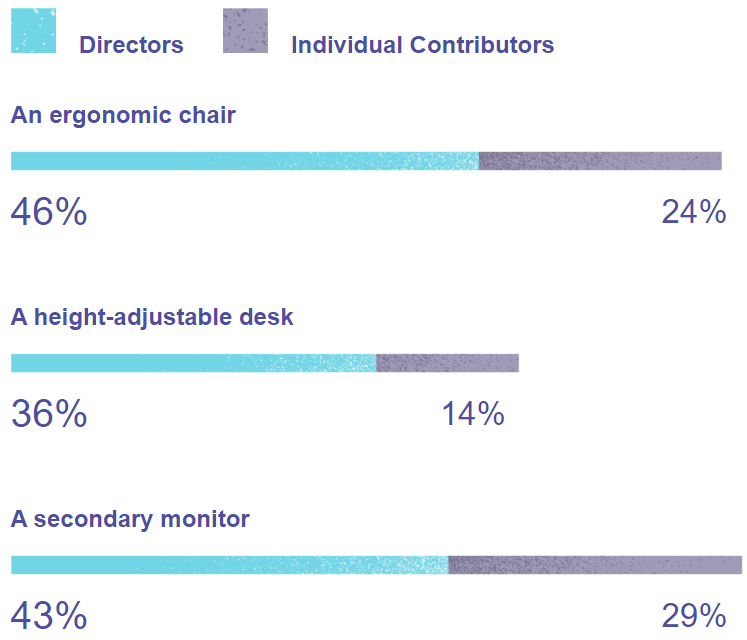We use cookies to make this site as useful as possible and maximize your experience. By closing this message, you consent to our cookies on this device in accordance with our cookie policy unless you have disabled them in your browser settings.
Work From Home Strategies Pt. 2

This article is the second in a series on work from home strategies in the post-COVID era. Read part one here.
In the first installment of our series on working from home, we discussed three common misconceptions about remote work that are not supported by the data. Next, we’ll do a deep dive into Misconception #1: the cost savings associated with telecommuting.
Misconception #1
“It costs less to have people work from home.”
Reality: It’s true that switching from office life saves on real estate costs and associated workplace amenities. But there are hidden costs to consider before sending people home full time. Everyone’s situation is different. The office has the potential to provide everyone with the spaces and tools they need to get work done. But when working from home, some people have to juggle small spaces, family and roommates along with poor equipment and technology.
Working from home is not possible for everyone. People may leave. Some senior leaders perceive that WFH has been widely successful, but the data tells a different story. Executives with larger homes and dedicated, well-outfitted home offices are doing fine. Their days are filled with video meetings reviewing the work of others. But their teams and more junior people, often with smaller homes, roommates or younger families, are already facing a number of challenges that are not sustainable.
Steelcase research found senior leaders (directors or above) have more access than individual contributors to:

The Steelcase research went on to say that 75 percent of directors or above report always or almost always working at a desk at home while only 46 percent of individual contributors do. And in large metropolitan areas around the world, people often grapple with small living quarters shared with others which can make working from home difficult.
Research from the Cheung Kong Graduate School of Business in Beijing found that more than half of workers said their efficiency declined while working from home. For people who don’t have an optimal home office, eliminating the choice to work from an office may make that job opportunity on LinkedIn more tempting. In fact, people who always or very often work from home are far less likely to say they’ll stay at their companies for their entire careers: 5 percent compared to 28 percent of those who never work remotely say they will (Workplace Trends and Virgin Pulse). Of people who work from home all or most of the time, only 5 percent say they’ll stay at their company through their career.
It’s harder to build relationships from home. Social capital helps people trust one another, and trust is the currency of innovation. In-person connections are most effective for building social capital and helping people feel a sense of community.
Reality: Too much remote work hurts social capital and slows innovation.
One of four main reasons people succeed working remotely is they’ve already worked with colleagues at a main worksite, according to Judy Olson, Ph.D. (University of California Irvine) who studies distance work, publishing over 100 research articles on the topic. People who’ve worked together in person, have built social capital—a set of shared values that allows them to work together effectively, she notes. This leads to trust, which is the currency of innovation.
In an interview with the Financial Times, Citigroup’s investment banking leader Paco Ybarra expressed concern that without in-person contact, at some point, the social capital remote workers are relying on right now will depreciate. To that point, previous experiences with large-scale, mandatory WFH programs show that the real problems don’t show up until after a year or so, as employee turnover begins to weaken the social networks that developed over years of in-person interaction. As social capital declines, morale decreases, turnover increases, productivity falls and eventually new leaders quietly abandon these programs and promote a return to the workplace (VitalSmarts).
Reality: The home office increases risk to employee safety and corporate security.
Most home offices don’t adhere to the strict safety measures that organizations must adhere to, prescribed by governmental agencies such as the Occupational Safety and Health Administration (OSHA) in the U.S., EU-OSHA in Europe, or the International Labour Organization in Asia. Regulations cover specific safety criteria for their workplaces but not for home offices (Forbes.com). Yet, workers in home offices are potentially at increased risk of tripping, fire hazards, inadequate lighting and poor ergonomics.
Organizations also need to consider the security of information or IP in a home office where there is less control over guests and who has access to home office whiteboards, desks, or sensitive documents that might be left out where others can see them. In fact, 84 percent of IT professionals say data loss is a significant concern when people work from home. The office is a more controlled work environment when it comes to worker safety and corporate security – and employers lose control and take on added risk as a greater percentage of their employees work from home.
In our next post, Work From Home Strategies Part 3 , we will look at the next common misconception about remote work: the productivity lie.
